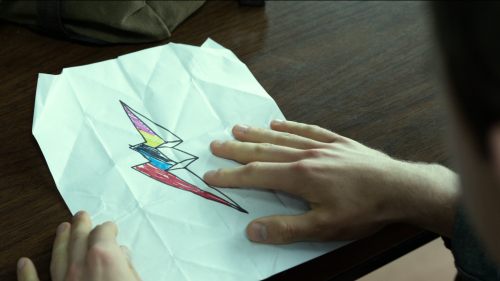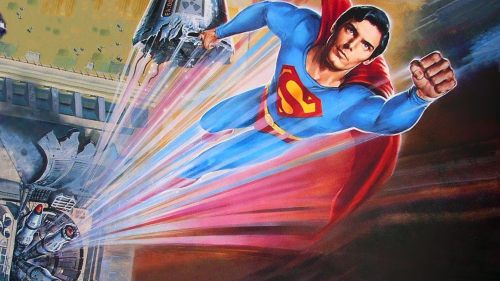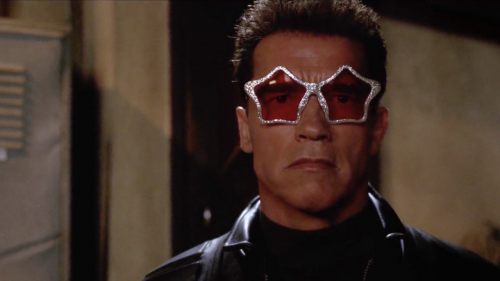Say Something Nice: THIRTEEN GHOSTS (2001)
Thirteen Ghosts (or THIR13EN Ghosts if you were one of the cool kids in 2001) is a remake of William Castle’s 1960 film of the same title. Castle was known for his gimmicks and clever marketing tactics. He created Illusion-O glasses for those “brave” enough to see the ghosts on screen. Audiences were given glasses with red and blue cellophane filters requiring viewers to look through a single color with both eyes, setting the glasses apart from traditional 3D glasses with one blue lense and one red. Choosing to peer through the red filter intensified the images of the ghosts, while the blue filter “removed” them. Director Steve Beck’s remake pays homage to the glasses by incorporating chemistry-lab-like spectacles allowing his characters to view spirits otherwise hidden to the naked eye. However, overall there are minimal similarities between the two films.
The plot of the original focuses on the Zorba family trying to cohabitate with thirteen unruly spirits, while the youngest son discovers his great uncle’s hidden fortune and has to fight off an evil lawyer who wants the treasure all for himself. The 2001 remake is basically a haunted house story jacked up on steroids and drenched in blood. Neither of the films provide an in-depth look at the thirteen ghosts’ backstory. Although, there is a Ghost Files clip on the remake’s DVD special features, which is pretty interesting if you want to dive deeper.
Beck sets the tone of his film right off the bat by revealing how ruthlessly the ghosts are captured and utilizes a nice nod to the violently swift camera work used in The Evil Dead. Cyrus Kriticos (F. Murray Abraham) is a wealthy ghost hunter in search of twelve uniquely sadistic spirits to complete the “Black Zodiac”, which will provide him the ability to see into the past, present, and future. Once the deadly dozen are enslaved, a thirteenth ghost of pure heart must sacrifice himself out of love in order to stop Cyrus’ plan and the subsequent “Eye of Hell” from opening. The first scene also introduces us to the loveable and jocular Matthew Lillard, who plays the psychic protagonist trying to stop Cyrus. Upon his death, Cyrus leaves his home to his estranged nephew Arthur (Tony Shalhoub), whose wife recently died in a house fire. Arthur, his daughter Kathy (Shannon Elizabeth), death-obsessed son Bobby (Alec Roberts), and sassy nanny Maggie (Rah Digga) all accompany him to their new, albeit hellish, abode.
The special effects makeup for the twelve ghouls is morbidly distinct and intricate with application processes that could take up to five hours at a time. However, despite creating creepy characters, the movie’s narrative is not cohesive; and there is a lack of true terror due to the silly one-liners and repetitive poor judgment calls from the Kriticos family. The dialogue and mythos around the story are far from compelling, which makes the comic relief from the supporting characters serve as a crutch to get through the entire film. Statements like “Come on, Glass Family Robinson” and “We have ten minutes until the ectoplasmic shit hits the fan” are threaded throughout the film’s ninety minute runtime. The editing is also exhausting. There are tons of close-up shots and excessive flashes of light between kills or any sort of action when the ghosts are present, which instead of coming off as scary, just makes you feel like you’re wasted and stuck in a loud Halloween-themed nightclub.
Despite Thirteen Ghosts earning a spot on Roger Ebert’s “Most Hated” list and accruing 14% on Rotten Tomatoes, the real redeeming beauty of this film lies in the unconventional production design. When it’s mentioned that Cyrus squandered the family fortune, he no doubt put that money into the house that encapsulates his vengeful spirits. While most haunted houses are depicted in a decrepit, gothic nature, Thirteen Ghosts challenges this stereotype by introducing audiences to a sleek, all-glass dwelling that looks like a futuristic marvel. Production designer, Sean Hargreaves, based the layout of the house off of the New York Science Museum’s architecture. It took three months to design the set which consisted of more than three miles of etched glass walls and a total of 8,500 square feet of glass. Welders were brought in to fuse the house together using five tons of steel, and the production crew had to wear all black because of reflection challenges during filming. The design of the mansion is a key element to the script and overall Black Zodiac narrative. The house is technically called Basileus’ Machine, named after the 15th century astronomer Basileus, who, while under demonic possession, documented its blueprints in an ancient book called “The Arcanum”. It is “designed by the devil and powered by the dead” with walls containing ectobar glass and Latin etchings serving as containment spells for the twelve earthbound spirits who are released one-by-one to power up the machine.
The walls move and shift like a giant Rubik’s cube; and gears grind loudly, trapping the family inside to ward off the ghosts for a CGI saturated climax and predictable twist at the end. While the film isn’t entirely noteworthy, it solidifies its place among the corny movies from the early 2000’s. Cyrus’ haunted house is a work of art, and ultimately adds a memorable piece of real estate in the horror genre’s spooky neighborhood.



